
 |
Tea Clipper |
 |
| from TeaAntiques.com | ||
| Edition Fifty Nine |
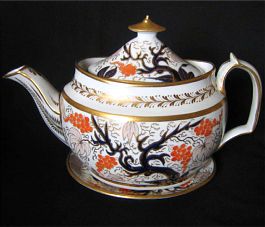 An
attractive New Hall teapot and teapot stand, beautifully decorated with pattern
number 446, this in an 'Imari' palette, depicting a / fruiting grape vine.
The teapot and the stand are both marked with the New Hall pattern number 446, as
well as a workman's mark. This teapot and stand would have been made at the New
Hall works c1810.
An
attractive New Hall teapot and teapot stand, beautifully decorated with pattern
number 446, this in an 'Imari' palette, depicting a / fruiting grape vine.
The teapot and the stand are both marked with the New Hall pattern number 446, as
well as a workman's mark. This teapot and stand would have been made at the New
Hall works c1810.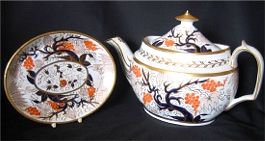
The body of the teapot and the teapot stand are decorated with the fruiting vine pattern. There is an under glaze blue used to create the trunk of the vine. From this blue trunk emanate a wealth of fine gilt branches. Hanging on the branches are bunches of orange grapes and vine leaves outlined in gilded line form with dotted leaf veins.
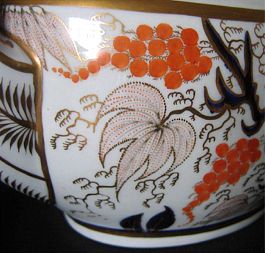
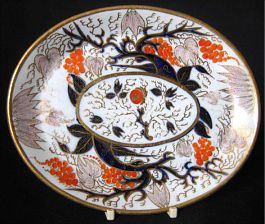
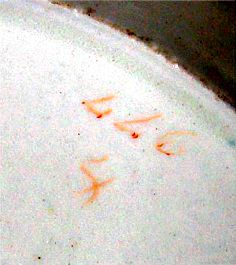
It is wonderful to have the teapot complete with its original stand and all in very good condition. A most handsome Teapot and stand for the collector of New Hall or early English porcelain.
More details of this item and other tea related antiques can be found by visiting my web site at www.TeaAntiques.com.
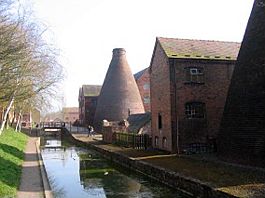 Set
a little way along the River Severn from Ironbridge, in the Ironbridge Gorge, is
the Coalport China museum. It was in the 1790's that Coalport really expanded and
became a centre for the manufacture of porcelain. The industry was set up at Coalport
by William Reynolds, an ironsmith, but it was he who brought porcelain making together
with chain making and boat building to the area. The Shropshire canal was extended,
and together with the River Severn, provided the essential transportation links
for the export of the Coalport porcelain around the world.
Set
a little way along the River Severn from Ironbridge, in the Ironbridge Gorge, is
the Coalport China museum. It was in the 1790's that Coalport really expanded and
became a centre for the manufacture of porcelain. The industry was set up at Coalport
by William Reynolds, an ironsmith, but it was he who brought porcelain making together
with chain making and boat building to the area. The Shropshire canal was extended,
and together with the River Severn, provided the essential transportation links
for the export of the Coalport porcelain around the world.
Although production at the Coalport factory ceased in 1926, part of the works has been turned into a museum where a display of some of the beautiful Coalport creations can be exhibited. In addition to the museum china exhibition, there is a working part of the pottery where demonstrations of just how china items are produced and decorated.
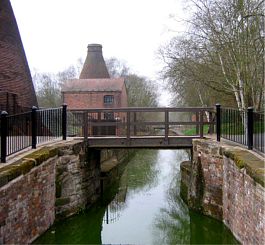 Coalport
porcelain has a rather entwined history. It was formed of several companies, the
first of which was that established by John Rose. He had previously been apprenticed
to Thomas Turner, of the Caughley factory, but aged 21, he set up his own business
with Edward Blakeway on the banks of the River Severn at Jackfields - the opposite
side of the river to the Coalport site we are on today. This business relationship
between these two men was established some time around 1793. The canal being on
the Coalport side of the river and the Hay incline plane having been built to overcome
the problem of getting materials up and down the gorge, the site was ideal.
Coalport
porcelain has a rather entwined history. It was formed of several companies, the
first of which was that established by John Rose. He had previously been apprenticed
to Thomas Turner, of the Caughley factory, but aged 21, he set up his own business
with Edward Blakeway on the banks of the River Severn at Jackfields - the opposite
side of the river to the Coalport site we are on today. This business relationship
between these two men was established some time around 1793. The canal being on
the Coalport side of the river and the Hay incline plane having been built to overcome
the problem of getting materials up and down the gorge, the site was ideal.
By 1799, the Caughley factory found itself in a dwindled state, with the business failing, it was sold off by Thomas Turner, to his previous young apprentice, John Rose and his partner Edward Blakeway. The next development in the Coalport story is that John Rose's brother Thomas Rose also set up a china works between the canal and the river at Coalport. Thomas Rose was in a partnership with William Reynolds and William Horton, but Reynolds died within three years and was replaced by his cousin Robert Anstice. This company then became known as 'Anstice, Horton & Rose' and operated there as a rival to John Rose's company.
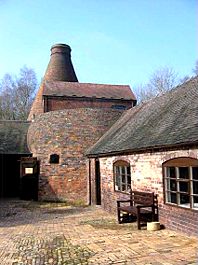 John
Rose went bankrupt in 1803 and his company was sold to Johnson and Clarke, but they
retained John Rose as the company's manager. The company became successful and indeed
bought out its rival firm of 'Anstice, Horton & Rose', merging the two companies
together. This united company saw other management and mergers in its history,
but essentially it became 'John Rose & Co.' and continued to produce its high
quality porcelain right through the nineteenth century. John Rose died in 1841,
but the work continued under the guidance of his nephew. In the nineteenth century,
there were many improvements to the porcelain produced by Coalport, including improvements
to the china body and to the glazes. Glazes had been lead-based and caused serious
health problems to the workers at the factory, so improvements were beneficial to
his work force.
John
Rose went bankrupt in 1803 and his company was sold to Johnson and Clarke, but they
retained John Rose as the company's manager. The company became successful and indeed
bought out its rival firm of 'Anstice, Horton & Rose', merging the two companies
together. This united company saw other management and mergers in its history,
but essentially it became 'John Rose & Co.' and continued to produce its high
quality porcelain right through the nineteenth century. John Rose died in 1841,
but the work continued under the guidance of his nephew. In the nineteenth century,
there were many improvements to the porcelain produced by Coalport, including improvements
to the china body and to the glazes. Glazes had been lead-based and caused serious
health problems to the workers at the factory, so improvements were beneficial to
his work force.
In 1926 the year of the General Strike, the Coalport factory closed and production was moved to Shelton in the Potteries. Other companies came to the Coalport site to produce wares and it was even later taken over by an exhaust pipe manufacturer - who vacated the site in 1976. The museum was then opened in 1977 as a fitting tribute to the excellent Coalport china manufacture.
Today, the visitor is greeted by the sight of the red brick buildings where the china manufacture took place and the beautifully shaped brick 'bell kiln' chimneys, where the china was fired.
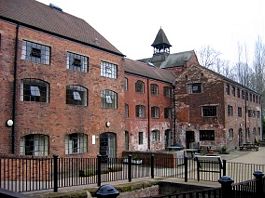
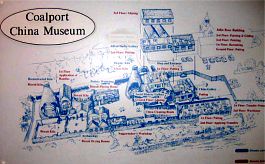
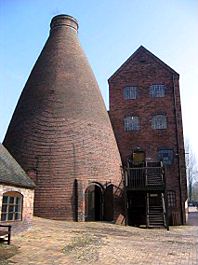
Entering the museum, the first thing to enjoy are cabinets filled with examples of the Coalport manufacture throughout its history - starting with the early wares. With so many pieces of Coalport porcelain on display, it is hard to take it all in on one visit!
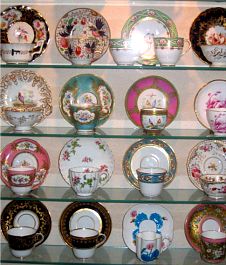
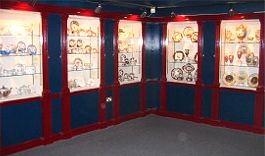
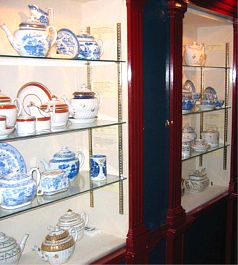
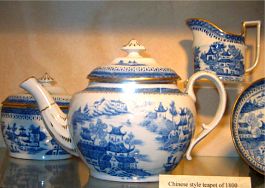 I
was delighted to see an array of Coalport tea wares, including many different designs
and decoration on teapots, tea cups and saucers, etc. The early examples of tea
wares show the fashion of copying the Chinese oriental blue and white landscape
scenes. Other factories too, such as Caughley and Worcester had been producing reasonably
priced tea wares in this sort of design - each trying to fulfil the demand for such
porcelain by the growing middle classes and their growing passion for tea drinking.
I
was delighted to see an array of Coalport tea wares, including many different designs
and decoration on teapots, tea cups and saucers, etc. The early examples of tea
wares show the fashion of copying the Chinese oriental blue and white landscape
scenes. Other factories too, such as Caughley and Worcester had been producing reasonably
priced tea wares in this sort of design - each trying to fulfil the demand for such
porcelain by the growing middle classes and their growing passion for tea drinking.
Here, there is a smooth oval shaped body, moulded curved and gilded spout, oval lid and finial also with gilded embellishments. This set with its Chinese landscapes dates from the first few years of the 1800's.
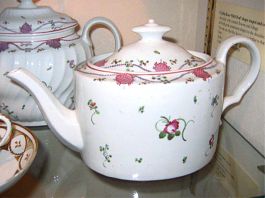
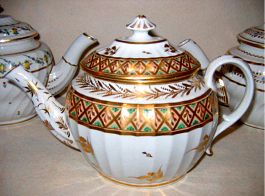
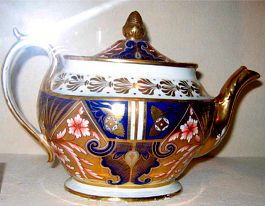
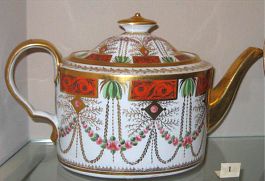
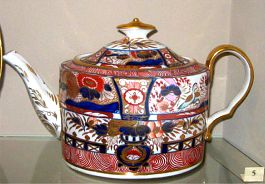
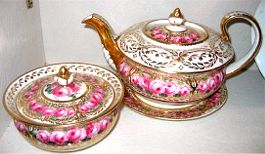
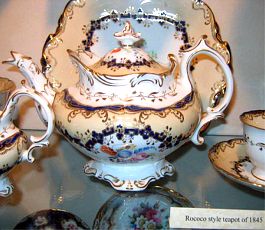
Moving on in date, these two teapots above are from a little further into the nineteenth century. The set to the left, painted with gorgeous pink roses and richly gilded would date from c1820-40. The teapot to the right, moulded and shaped in a rococo style, with a pale orange ground colour and painted panels of flowers dates from c1845. This shape is very much what I regard as a typical style of the mid-Victorian era. Such sets would come complete with matching rococo milk jug, sugar bowl, tea cups and saucers, plates and cake / sandwich plates.
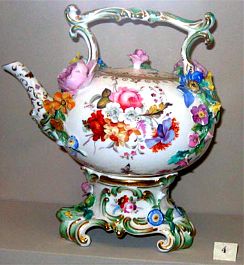 One
of the styles for which Coalport is well known, is the style where the body of the
item is encrusted with moulded and brightly painted flowers. One such piece on display
is a very rare tea kettle on a stand. This mid-nineteenth century tea kettle has
a compressed circular body, painted with a brilliant bouquet of flowers on each
side and is encrusted to the front and back with amazingly delicate flowers, each
moulded and applied by hand and brilliantly painted in bright colours. Even the
tea kettle's handle is of porcelain, imitating style of its more common silver counterpart.
Like the kettle, the stand is decorated in the same way with painted and applied
flower, raised on scrolling feet.
One
of the styles for which Coalport is well known, is the style where the body of the
item is encrusted with moulded and brightly painted flowers. One such piece on display
is a very rare tea kettle on a stand. This mid-nineteenth century tea kettle has
a compressed circular body, painted with a brilliant bouquet of flowers on each
side and is encrusted to the front and back with amazingly delicate flowers, each
moulded and applied by hand and brilliantly painted in bright colours. Even the
tea kettle's handle is of porcelain, imitating style of its more common silver counterpart.
Like the kettle, the stand is decorated in the same way with painted and applied
flower, raised on scrolling feet.
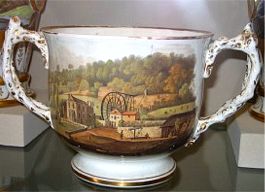
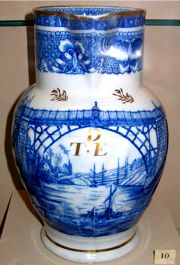
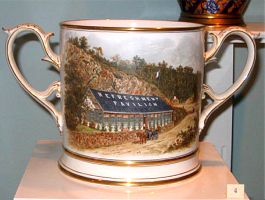
As well as the tea wares, which of course were of particular interest to me, there are many other fine pieces of Coalport to be seen. Some items are very relevant to the factory or to the area of Ironbridge and its industrial revolution. The jug above shows the Ironbridge itself, the first cast iron bridge to be built in the world, built by Abraham Darby III in 1779. The loving cup to the right is painted with a 'Refreshment Pavilion', this actual building is now in the Blists Hill Victorian Town museum nearby. The Pavilion originally stood at the foot of a picturesque hill, 'The Werkin' to which people would travel as a natural beauty spot. The 'Refreshment Pavilion' was built in 1889 to provide the visitors to the hill with refreshments after their climb up the hill.
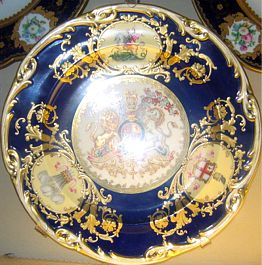
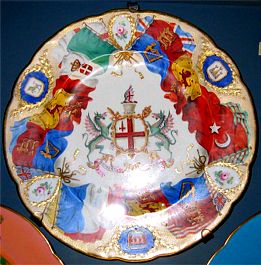
To touch on a few of the grander Coalport commissions, which came with its world wide popularity and acclaim, there are some stunning examples of Royal Commissions for Queen Victoria. These exquisitely decorated plates above, are from services ordered by the Queen for use at various diplomatic visits and banquettes. The richness and attention to detail is to be applauded and shows just how refined Coalport production had become.
Having feasted on the beautiful wares produced by the Coalport factory. I left the main museum displays and ventured across to another building in complex, where there is still some manufacture demonstrations showing the techniques used in the manufacture of Coalport porcelain. There are also some old photographs showing the workers of the factory, the two below show painting by hand and transfer printing of designs to go onto porcelain.
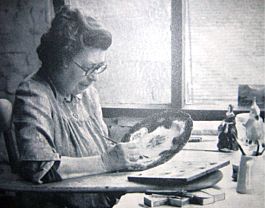
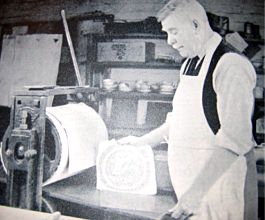
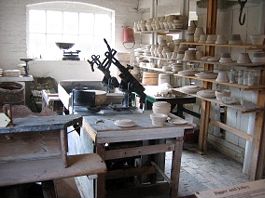
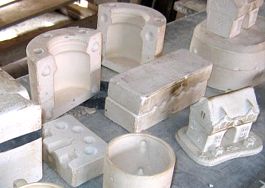
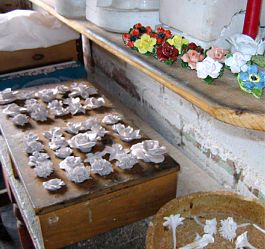
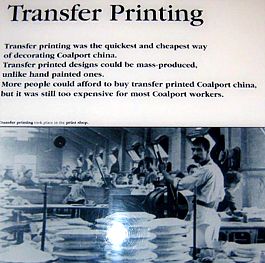
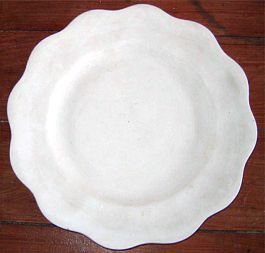
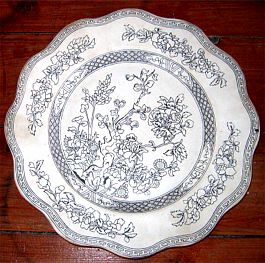
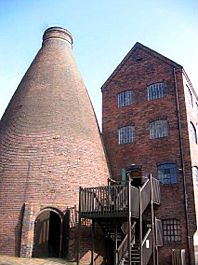
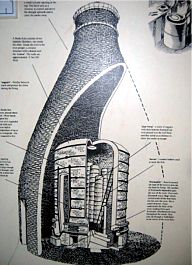 My
final interesting thing to see was the inside of the elegantly shaped bottle kilns
or ovens. This magnificent brick structure comprises two separate chambers. The
outer brick 'bottle' shaped construction, known as 'the hovel' was built to a height
of 24m (80ft). There is a hole in the top and the structure acted as a chimney through
which draught could be controlled and which blew upwards carrying the smoke away.
Inside the hovel was the second construction-the kiln itself. The kiln was a circular
construction, with a domed roof, its walls 0.3m (1ft) thick were built of fireclay
bricks. For additional strength and support needed during the hot firing process,
there are Iron bands around the body of the kiln at 1ft intervals.
My
final interesting thing to see was the inside of the elegantly shaped bottle kilns
or ovens. This magnificent brick structure comprises two separate chambers. The
outer brick 'bottle' shaped construction, known as 'the hovel' was built to a height
of 24m (80ft). There is a hole in the top and the structure acted as a chimney through
which draught could be controlled and which blew upwards carrying the smoke away.
Inside the hovel was the second construction-the kiln itself. The kiln was a circular
construction, with a domed roof, its walls 0.3m (1ft) thick were built of fireclay
bricks. For additional strength and support needed during the hot firing process,
there are Iron bands around the body of the kiln at 1ft intervals.
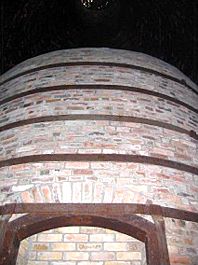 These
Iron bands are called 'bonts' and were necessary as the kiln would expand and contract
during each firing process. China was loaded into the kiln via a tall doorway, tall
enough for a man to walk through carrying the china filled sagger on his head. The
saggers protected the china from the hot flames, ashes and smoke during firing.
Once the kiln had been filled with the saggers, the doorway used to fill the kiln
was bricked up, sealing the kiln. A number of fires were then lit around the base
of the kiln, these fires were lit in what were called 'firemouths'. A series of
flues in the floor of the kiln took the heat from the fires up into the centre of
the kiln through a 'well-hole'. the temperature of the kiln was raised to temperatures
up to 1,250°C. The temperature of the firing depended on what stage of production
the wares had reached. Decorated wares requiring a slightly cooler temperature and
the firing of the gilded pieces requiring a slightly cooler temperature again. There
were variations in the temperature within the kiln in different locations, so different
wares were placed in certain locations.
These
Iron bands are called 'bonts' and were necessary as the kiln would expand and contract
during each firing process. China was loaded into the kiln via a tall doorway, tall
enough for a man to walk through carrying the china filled sagger on his head. The
saggers protected the china from the hot flames, ashes and smoke during firing.
Once the kiln had been filled with the saggers, the doorway used to fill the kiln
was bricked up, sealing the kiln. A number of fires were then lit around the base
of the kiln, these fires were lit in what were called 'firemouths'. A series of
flues in the floor of the kiln took the heat from the fires up into the centre of
the kiln through a 'well-hole'. the temperature of the kiln was raised to temperatures
up to 1,250°C. The temperature of the firing depended on what stage of production
the wares had reached. Decorated wares requiring a slightly cooler temperature and
the firing of the gilded pieces requiring a slightly cooler temperature again. There
were variations in the temperature within the kiln in different locations, so different
wares were placed in certain locations.
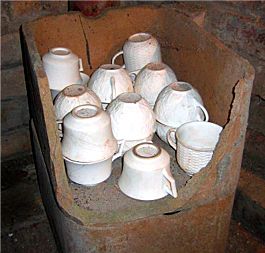
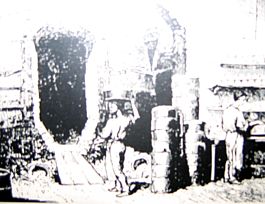
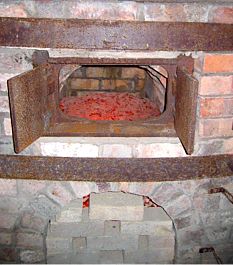
The first part of the firing process was known as 'smoking'. This 'smoking' was a firing at a low temperature which was carried out to drive unwanted moisture out of the wares. Following the 'smoking', which took about 48 hours, the temperature of the kiln was raised to 1,000 - 1,250°C. It was kept at this high temperature for about two or three hours, known as 'soaking'. After this period, the fires were allowed to burn out. The doorway was then un-bricked and the wares removed to go onto the next process in their manufacture.
This wonderful museum, set in the tranquil Ironbridge gorge is a delight to visit - the River Severn to one side of the museum and the Shropshire canal on the other. A must I think for those interested in porcelain manufacture from the end of the eighteenth century, through the nineteenth century and especially for those who delight in and collect the wonderful wares produced at the renowned Coalport factory.
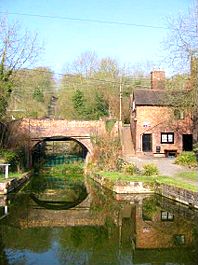
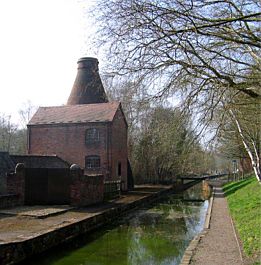
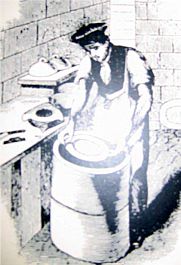
Coalport China Museum
Ironbridge
Shropshire
England
Website: http://www.ironbridge.org.uk/
Click here for
Local Map
Map courtesy of www.streetmap.co.uk
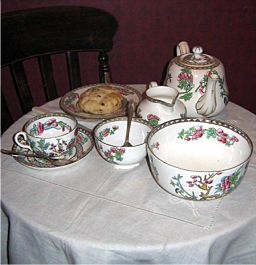 One
design that caught the public's imagination, was the 'Indian Tree' design. There
are two stories of how this design came about and when it was first produced at
the Coalport factory. The first says that the design dates as far back as 1801,
but there is no evidence of any actual pieces of this before c1820. It was said
that the pattern was based on a piece of silk owned by an officer in the Shropshire
Light Infantry. The second story of the pattern's introduction is that the pattern
was on a piece of paper that was used to wrap up some glass ware being returned
from India to a Birmingham glass company. Either way, the popularity of this 'Indian
Tree' pattern meant that there was one section of the Coalport factory dedicated
to producing only this!
One
design that caught the public's imagination, was the 'Indian Tree' design. There
are two stories of how this design came about and when it was first produced at
the Coalport factory. The first says that the design dates as far back as 1801,
but there is no evidence of any actual pieces of this before c1820. It was said
that the pattern was based on a piece of silk owned by an officer in the Shropshire
Light Infantry. The second story of the pattern's introduction is that the pattern
was on a piece of paper that was used to wrap up some glass ware being returned
from India to a Birmingham glass company. Either way, the popularity of this 'Indian
Tree' pattern meant that there was one section of the Coalport factory dedicated
to producing only this!
The 'Indian Tree' pattern was printed onto the blank wares and then coloured in by hand. It was used to train apprentices taken on at the Coalport factory. Many other factories copied and produced the same design, so great was the demand.
Within the Coalport museum, there is a tea table set with a tea set of the 'Indian Tree' pattern. Against a nice white table cloth, this delicate pattern looks as pretty as a picture!
To review past newsletters, just follow this link:
Past newsletters.
To subscribe to this free newsletter -
Click here